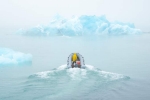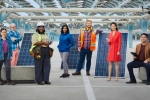
Episode 3 - Energy transition: Closing the gaps
Subscribe to our podcast
To limit global temperature rise to below 1.5 degrees Celsius, the Paris climate agreement requires a significant transformation of the energy system, transitioning from fossil fuels to renewable choices, and reducing greenhouse gas emissions across all sectors. However, this is easier said than done.
In this episode we speak with Jon Chadwick, PwC's Global Sustainability Lead in Energy Transition (PwC Australia) and Sean Purdie, Asia Pacific Sustainability Energy Lead (PwC China) who discuss how to bridge the gaps to achieve our energy transition goals and the actionable steps to accelerate this journey.
Release date: January, 2024
Full transcript
Ivy Kuo: Hello, I'm Ivy Kuo, PwC Asia Pacific Sustainability Leader, and you're listening to PwC's ESG (Environmental, social and governance) podcast, Defining Asia Pacific's Future. The podcast for bite size updates on the latest sustainability trends, from climate change to social and labour rights due diligence. We bring together ESG practitioners to discuss and solve today and tomorrow's sustainability challenges. Reflecting PwC's strategy of building trust and delivering sustained outcomes. Following the success of earlier episodes, I'm pleased to announce that we will feature various PwC sustainability specialists in this podcast series.
In this podcast, we explore a critical pathway to net-zero energy transition in Asia Pacific. Join us as we discuss how to bridge the gaps to achieve our energy transition goals.
To limit global temperature rise to below 1.5 degrees Celsius the Paris climate agreement requires a significant transformation of the energy system, transitioning from fossil fuels to renewable choices, and reducing greenhouse gas emissions across all sectors. However, this is easier said than done.
In this episode, I have the privilege of hosting Jon Chadwick, PwC's Global Sustainability Lead in Energy Transition (PwC Australia) and Sean Purdie, Asia Pacific Sustainability Energy Transition specialist (PwC China). They will share their valuable insights on the current energy system in the region, the challenges and gaps that require our focus and attention, and the actionable steps to accelerate this energy transition journey.
Welcome Jon and Sean. Thank you for joining us.
Jon, let's start with you. What does the current energy landscape in Asia Pacific look like and what gaps do we need to bridge for Paris Agreement energy transition goals?
Jon Chadwick:Thanks, Ivy. Really excited to be here today.
I guess the first thing to cover off when we talk about Asia Pacific, is that the region itself is so diverse and complex. We've got different levels of development, different levels of energy demand, different resource availability, and emissions intensity right across the region. So, as we talk about the region, it's really unfair to treat this all as one single region. We really need to look at the different countries that make up the regions and the complexities that each country is dealing with.
Now, it's also important to remember that the region accounts for more than half of the world's energy consumption and greenhouse gas emissions, and this is expected to continue to rise as the population grows and the economies continue to grow as well.
So, we've got a diverse landscape. We've got over half the world's energy consumption and greenhouse gases. This is only going to rise and grow. On top of all this, we now have significant challenges from climate change. We've got extreme weather events, we've got sea level rising, we've got water scarcity, so that's really affecting us from an environmental and economic stability perspective as well. So really, to get to that Paris Accord level we really need to bridge four key gaps.
The first is the investment gap. Asia Pacific as a region requires an estimate of US$1.5 trillion a year of investment in clean energy and low carbon infrastructure to get to that net-zero goal. But current investment levels are way too low. Well below this level.
The second is the technology gap. Asia Pacific as a region really needs to scale up the deployment and innovation of technologies that can help us decarbonize specifically the energy, industrial, and transport sectors with things like renewable energy, energy efficiency, carbon capture, hydrogen and electric vehicles.
Third is the integration gap. I spoke before about the region being a diverse region with lots of different challenges, but how can we start to look at this as a region? How can we integrate the energy systems, the energy markets and the policies, or at least begin to align them better to give us and to ensure a more reliable, affordable, and clean energy system that will give us that cross-border cooperation and trade.
And last but not least, the incentive gap. The region needs to align the incentives and regulations of its governments, utilities, and companies to really foster that environment for the energy transition to really get us through not just the economic impacts, but also the social impacts and really look at how we can help the affected communities and workers as the whole economy transitions to that new carbon-neutral or carbon positive economy.
Ivy Kuo:Thank you, Jon. That was quite insightful.
How can an energy system become more reliable, affordable, and cleaner while we also look at the economic growth for the region?
Jon Chadwick:Yeah, great question, Ivy.
Just building on my answer before, we really need to look at the holistic and systemic approach to this. We need to look at a few different aspects as we do that.
First is the energy mix. How do we diversify the energy system and the energy sources that we use to reduce the dependency on fossil fuels? We need to do that by increasing the share of clean and renewable energy such as solar, wind, hydro, biomass, and in some cases even nuclear. And we need to use that and use transition fuels such as natural gas and get into the molecule side of things with hydrogen, et cetera, where appropriate.
The second would be energy efficiency. So, we need to improve how we're using the energy that we're using today. We need to reduce the energy intensity by implementing measures like smart grids, demand response, energy storage, distributed generation, digitalisation, and really start promoting behavioural changes in how business processes are designed, consumers behave, and the way the producers behave as well so that we are looking at both the supply and the demand side of this energy equation.
Third, would be around energy resilience. So we need to enhance the system's resilience and adaptability to the climate change impacts that I mentioned before as well as disruptions. We need to strengthen the infrastructure, diversify the supply chains, and improve the risk management that we're putting around all this. And we really need to be investing and innovating around climate adaptation and mitigation solutions.
And last but not least would be the energy innovation. We need to foster a culture of innovation and collaboration. We need to better support research and development. We need to facilitate technology transfer and diffusion. We have to create enabling policies and regulations and engage with the right stakeholders across academia, industries, civil society, and international organisations to bring the best solutions to bear and connect them up as a whole system.
Ivy Kuo:That systematic approach is definitely very important to consider.
Anything from you, Sean?
Sean Purdie:Yes.
Likewise, I'm very pleased to be here today with you, Ivy and Jon. And I'd just like to expand on what Jon's saying that on a positive note, renewables is the cheapest source of electricity in countries representing 96% of global electricity generation. Those are 2022 figures.
In 2014, the bulk of new electricity generation built in the cheapest format was still thermal power, so that's a huge advance. However, we also have to recognise that up until the present date, there have been a lot of new coal and gas fired, particularly coal-fired power plants built, which have a long life and still have immense value and are the lowest cost base load generation across Asia Pacific. Countries such as Indonesia, Vietnam, and the Philippines are great examples of this.
However, as Jon mentioned, the more we have policies and regulations that encourage investment outside of existing thermal power, that new generation is building utilising renewables technology, the closer we will get to the requirements under the Paris Agreement.
One of the comments is that a lot of the new forms of renewable generation use a lot of land, so we have land competition as well. For example, in the Philippines with its burgeoning population, there's a lot of pressure on agricultural land. There's more agricultural land needed to feed the growing population, and solar power plants, for example, require up to 10 times as much land area as different types of thermal power generation.
So, all these considerations have to be included as part of the energy transition, and I think we'll talk about the just energy transition side of it a little bit later in this podcast.
Ivy Kuo:Thanks, Sean. That was very insightful and I always love the numbers.
Now let's go back to Jon.
I think technology is a very important part of driving energy transition, so what technologies can really help us in this decarbonizing journey for the different sectors?
Jon Chadwick:Thanks, Ivy. This is where the nerd in me takes over. I love the emerging technologies here and looking at how they can all play together. It's really exciting.
Definitely the first would be renewable energy. As Sean said, solar, wind, hydro, biomass, et cetera are really pushing us forward, and more and more countries are taking them on and they're the most dominant source of electricity in many countries, and that will only continue to increase. An important component to add to this of course is storage. There's a lot happening in the storage space that's a very fast evolving market around technologies, around price, around supply chains, et cetera. So, definitely watch that space.
The first one, definitely renewable energy and storage. Second one, as I mentioned earlier, was around energy efficiency. So, really technologies that are reducing and allowing us to reduce the amount of energy required to do a task, whether that's lighting or heating or cooling or mobility. But by looking at the way that we can improve the design and operation and maintenance of all of our equipment, appliances and buildings and vehicles, that's really going to have a huge impact.
Third will be around carbon capture. I know this can be a controversial one, but those technologies that can capture and store the CO2 (carbon dioxide) that's emitted from the fossil fuels and industrial processes that currently rely on those, I think is going to be important as a transition piece. Unfortunately, those fossil fuels aren't going to go away on the flick of a switch, so we need to find ways to make them cleaner through this transition.
Next one would be hydrogen. Again, this relates to storage and very much related to the renewable energy side, but how do we get to the clean versions of hydrogen? There will be a place for clean molecules as well as clean electrons across the economy and across our energy system, and it's believed right now that hydrogen will be a key part of that. So, really we need to figure out how to produce, store, transport and use hydrogen as that clean and versatile energy carrier for us. So that's going to be important.
And then lastly, specifically around the transportation sector, how do we clean that up using hydrogen as well as electric vehicles? We need to change those fossil fuel based vehicles to ones that are either running from hydrogen or electricity using batteries, fuel cells, overhead wires, or can be charged from renewable low carbon sources. We really need to be focused on that, and there's a tremendous amount of technology coming through in those spaces.
Sean, anything to add from an Asia Pacific perspective?
Sean Purdie:Yes. Well, first I'll mention the cliche, which is the energy trilemma, and so when we talk about renewable energy, we always have to include the volatility of solar power and wind power, for example. So therefore, we are going to need a huge investment in different types of storage technology, be it battery storage, be it mid-range storage with compressed air, compressed CO2, the other technologies being talked about, and deep storage, which is the current name, for example, pump storage hydro.
That means there'll be implications and massive investment requirements into transmission and distribution electricity grids. What we see when investment in renewables continues too quickly is pressures on the grid, the restrictions on dispatching new renewable energy, and curtailment of contracts, which scares investors a lot if they produce the electricity needed, but they're not able to dispatch it and then there's contractual difficulties regarding curtailment. A combined investment with renewables in storage and electricity transmission, distribution grids is needed.
The second point I'll make is I know you've mentioned hydrogen Jon, and over the past 12 months, I'd say that hydrogen has been on everyone's lips and will continue to be spoken about very strongly. Recently, in Japan, in discussions with a number of the Japanese trading houses and electricity utilities, of course we spoke about hydrogen. But we also spoke about different types of green fuels, particularly green ammonia and e-methane. There needs to be a lot of technology solutions produced, but there's a lot of investment time and money going into these solutions.
Hydrogen has some advantages, but it has some disadvantages, particularly on the transportation side and production side. The volumes needed to meet the energy transition, so there was a lot more discussion about green ammonia and e-methane with some of the parties I spoke to in Japan.
So, I think in summary, what we can say is that on balance, there'll be many different types of technologies utilised, hydrogen certainly being one of them, to meet the requirements of the energy transition.
Ivy Kuo:Thank you, Sean. I think that set up the landscape for Asia Pacific quite well.
You spoke about the different challenges and what needs to be done. Can we lay it out specifically for not just the challenges but also the opportunities that we see in the market for not just energy but also mobility transitions for our region?
Sean Purdie:They vary depending on the level of development, energy demand, resource availability, and emissions intensity, but some common themes are balancing economic growth, social equity, and environmental sustainability, which links into the energy train limit, which I mentioned before. It also means that governments and ministries will need to set policy and regulations that allow that investment, allow that energy transition to happen. We need to make sure that the investment incentives and domestic policies attract both new technology and allow existing technology to be upgraded as appropriate to meet these new challenges.
Two things I'd like to mention regarding energy transition, and one of the opportunities particularly in electric vehicles and mobility is critical minerals. There are going to be increasing demands on a range of valuable minerals that aren't utilised so much in the existing world economy. Lithium in particular, magnesium, other critical minerals that are going to be needed for particularly the transition to electric vehicles and different mobility systems will produce pressures on supply chains, produce pressures on timeframes to produce those technologies.
I'll also mention supply chains. Offshore wind is going to be a major part of the energy transition, and what has impressed me is the rate of take up of offshore wind, particularly in North Asia and now spreading to other parts of Asia and Australia and New Zealand. But with that uptake, it puts pressure on the supply chain, both from transportation such as shipping, installation, port facilities, and volumes, and the actual turbine manufacturers themselves. There's a lot of analysis and discussion, but in the short term, that's going to put pressure on prices and timeframes.
Ivy Kuo:Thank you Sean.
I think I want to draw Jon back into this conversation. We spoke a lot about the opportunities, the challenges, et cetera.
Jon, can you give us a quick summary of the action steps that must happen now to address this issue?
Jon Chadwick:Thanks, Ivy.
In terms of action right now, we've talked a lot about governments and utilities and the supply side and how companies can help with that, but I think we have to remember, we all have a role in this. This is an energy system which has a supply side, which most of the conversation and the global conversation has been about, but there's also a demand side, and both sides of that conversation have to have an equal voice in this, to take that system-wide approach that we referred to earlier.
If we look at achieving the Paris 1.5 degree scenario, in fact, 45% of the actions and the greenhouse gas emissions reductions has to come from the demand side. Every company, everyone has a role to play in this, and every company needs to be looking at how they're using energy, what their energy transition strategy actually is. What actions do they need to take on their own operations? What assets do they have that can play into the energy transition A, to mitigate risk, B, to add to the system, and C, to look for opportunities to evolve their business and add to their enterprise value.
I think, Ivy, for me, it's putting the challenge out there to every company to look at what their energy transition strategy is and how that aligns with their overall enterprise strategy.
Ivy Kuo:Jon and Sean, thank you very much for joining me for this special episode on energy transition.
The discussion has shown us that each territory in Asia Pacific is different and unique with its own advantages and disadvantages for the energy transition journey. The variation of progression very much depends on their level of development, energy demand, resource availability, and emission intensity.
However, what comes with challenges comes with greater opportunities. Now is the time. There are significant opportunities for businesses to reassess their priorities, transform their business models, and create sustained value for the future.
Let's join forces and collaborate to seize these opportunities and drive for a positive change for a cleaner future.
PwC refers to the PwC network and or one or more of its member firms. Each of which is a separate legal entity. This content is for general information purposes only and should not be used as a substitute for consultation with professional advisors. All opinions are our own and not reflective of any organisations with which we may otherwise be associated.
© 2023 PwC. All rights reserved. PwC refers to the PwC network and/or one or more of its member firms, each of which is a separate legal entity. Please see www.pwc.com/structure for further details. This content is for general information purposes only, and should not be used as a substitute for consultation with professional advisors.
Contact us

















